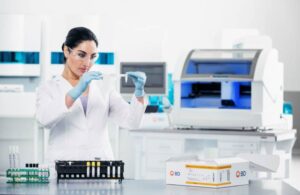
It’s been a busy time for BD, with recent approvals further driving the company’s diagnostics business forward.
Dave Hickey and BD (NYSE:BDX) have their sights on what they call “transformative forces.” These forces could change the delivery of healthcare going forward.
Hickey, EVP and president of the Life Sciences segment at BD, said these forces include smart connected care, migration to new care settings and improving chronic disease outcomes.
Digitization and automation, plus point-of-care and at-home testing, comprise these areas. That’s where BD’s focus lies.
“Our innovation strategy and our investment dollars are going into those areas,” Hickey told MassDevice.
Recent news along these lines includes the February FDA emergency use authorization (EUA) for BD’s COVID-19, flu and RSV combination diagnostic. Just weeks later, the company received approval for its Onclarity HPV assay for use with the ThinPrep Pap test.
Hickey explained how the company got to this point and how it aims to approach these transformative forces.
Working through the COVID-19 pandemic
Over the course of the last three years, BD developed a range of solutions for COVID and combination testing. Using a molecular platform, the company developed combination COVID assays, standalone assays and more, including the COVID/flu/RSV diagnostic.
BD has the Veritor point-of-care rapid antigen platform that can perform COVID combination testing in 15 minutes or less. Hickey explained that, once at-home testing became more comfortable for the population, BD developed the world’s first digitally read, at-home test using a simple nasal swab.
“We knew that testing at the point of care was going to be critically important,” Hickey said. “For us, developing a suite of solutions to accommodate COVID in combination testing — irrespective of where the testing will be done — was very important.”
Over the past year, the company operated with the notion that the pandemic would move toward an endemic setting. BD expected that to lead to a decline in standalone COVID testing. Ahead of the recent respiratory virus season, that led to the migration from standalone COVID testing to combination testing.
“What that does is that speeds up the time for diagnosis because you’re able to look for four major viruses, respiratory viruses at the same time,” Hickey pointed out. “It increases lab capacity because, in one test, you’re actually you’re doing four tests in a way. The BD Max is a fully automated sample-to-answer platform. So, in just about two hours, you can put this sample on at the beginning and get diagnostic insights around to two hours afterward.”
BD addresses healthcare shortages with automation and connected care
Looking at healthcare, there is a clear shortage of professionals, including acute nursing shortages, Hickey said. That extends to the lab, too.
According to the BD executive, laboratory technicians come in short supply, too.
“To have a fully automated sample-to-answer solution is important,” Hickey said. “That means that one lab tech can just load the sample at the beginning on the BD Max, press ‘start,’ walk away for a couple of hours, do other critical tasks in the lab and come back to the results there. We think that the automation trend is going to be really important to lab medicine.”
As the labs face shortages, lab tech schools can become feeders into the laboratories. However, Hickey said they’re failing to get the enrollment needed to keep labs running with the required number of workers.
Hickey said BD sees a way to remedy that. He believes the “requirement” to innovate, invest in and release automation and digitization solutions for what previously served as traditional lab testing procedures represents a “key strategic driver.”
“The way technologies move between different labs is very different compared to what it used to be,” Hickey explained. “Lab managers, directors, hospital executives, they need automation to process all the testing that goes on. Not only do we provide the automation solution itself, but we provide all the reagents and consumables and the tests that get run on the automation.
“We’re able to place the equipment, provide reagents, provide the service so customers can ultimately get the automated digital solution they need. It solves the staffing problems and still improves the service level of delivery to clinicians and the patients they serve.”
The new standard of care
Hickey said that, in responding to the pandemic, BD learned a lot about the direction in which it wanted to go. It wasn’t just about innovating for COVID, he explained, but finding a new go-to solution.
“We had to respond to the pandemic,” he said. “Now, we do believe that combination testing — the ability to test for multiple viruses at the same time, using a single sample in a fully automated fashion — we believe that’s going to become the standard of care.
“And it’s not just for now.”
Beyond COVID, respiratory virus seasons always exist. Winter in the Northern Hemisphere is followed by winter in the Southern Hemisphere, and it continues back and forth.
Hickey said that meant BD had to innovate to be “future-proof.” That’s where smart connected care, automation and chronic disease come in.
“BD, overall, has got its eyes very firmly fixed on these three transformative forces,” Hickey said. “All three of them have got a significant amount of relevance in life sciences. There’s a lot of exciting stuff going on tied to these three transformative forces.”